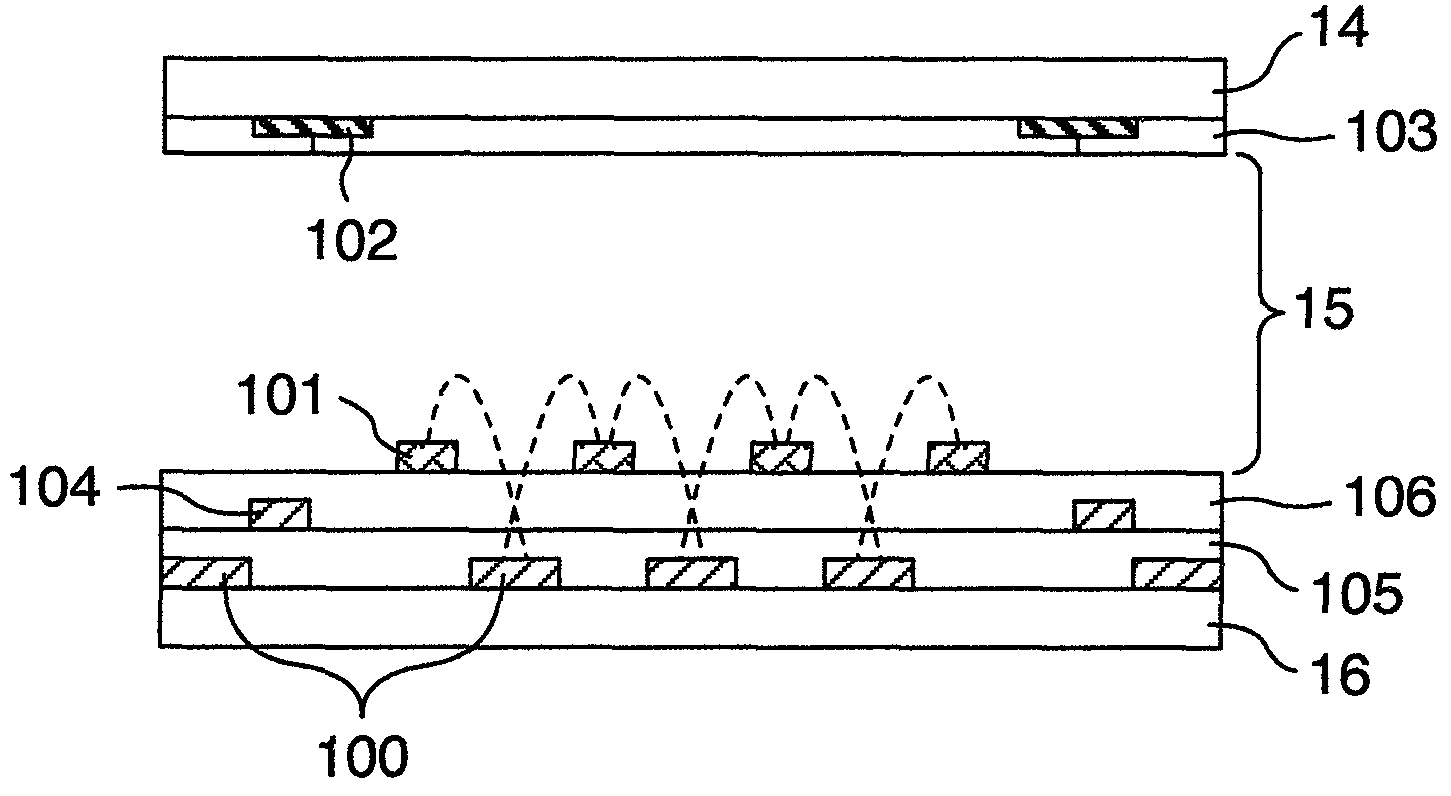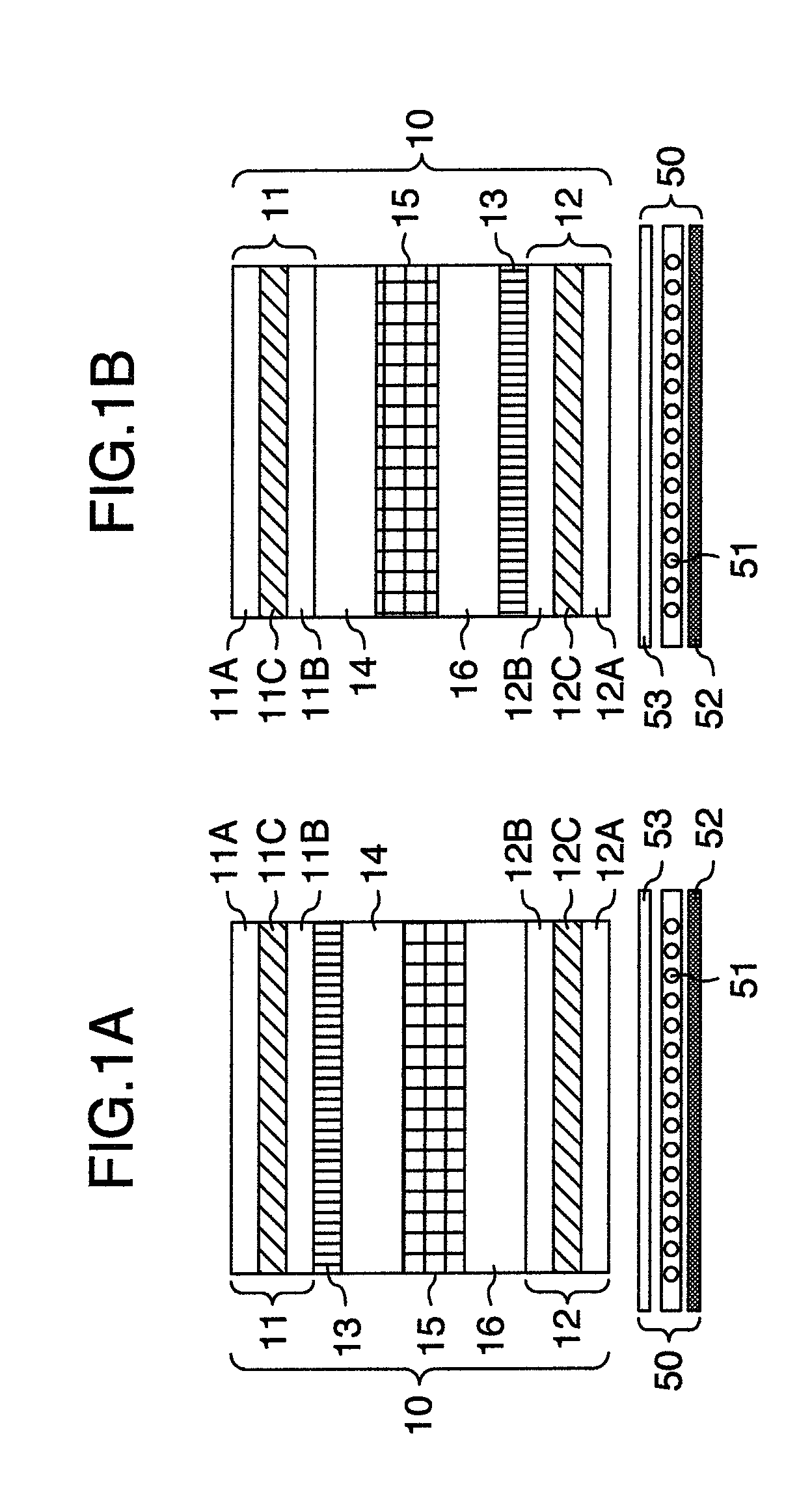Liquid crystal display device
a liquid crystal display and display device technology, applied in liquid crystal compositions, instruments, chemistry apparatus and processes, etc., can solve the problems of reducing the cr ratio when viewed at an oblique angle, deteriorating color reproduction at low grayscale levels, etc., to achieve high cr ratio, improve tonality, and improve color reproduction.
- Summary
- Abstract
- Description
- Claims
- Application Information
AI Technical Summary
Benefits of technology
Problems solved by technology
Method used
Image
Examples
embodiment 1
[0081]The construction of this embodiment is shown in FIG. 10 and its optical configuration in FIG. 11. The optical configuration of FIG. 11 is optically equivalent to FIG. 6.
[0082]The display device shown in FIG. 10 differs from the laminated structure of FIG. 1B in that a second optical phase compensation film 17 is disposed between the first optical phase compensation film 13 and the first substrate 16. Further, the construction of this embodiment is characterized in that the support members 11B and 12B are optically isotropic and that two optical phase compensation films (the first optical phase compensation film 13 and the second optical phase compensation film 17) are used.
[0083]Eliminating from the laminated structure of FIG. 10 those members which do not influence the optical characteristics—the support member 12B, the support member 11B, the liquid crystal layer 15, the first substrate 16 and the second substrate 14—results in a construction of FIG. 11. In FIG. 11 the same ...
embodiment 2
[0089]The construction of this embodiment is shown in FIG. 1B and its optical configuration in FIG. 8. In this embodiment, a common TAC film is used for the support member 11B, and the support member 12B for the polarization plate is optically isotropic. The common TAC film has a very large Nz coefficient, much greater than 0.5. So, as the Nz coefficient of the first optical phase compensation film 13, a value of 0.3, smaller than 0.5, was chosen. Here, the TAC film has a very small in-plane phase difference and thus can be considered to be almost equivalent to a monoaxis anisotropic negative c-plate. Therefore, for the retarded phase axis direction of the TAC film, the effects of this invention can be fully produced also in other directions than the direction indicated by 11B-S in FIG. 6. The first optical phase compensation film 13 is formed mainly of polycarbonate. A viewing angle (azimuth angle) dependency of the transmittance at a viewing angle (polar angle) of 60 degrees in bl...
embodiment 3
[0090]The construction of this embodiment is shown in FIG. 12 and its optical configuration in FIG. 8.
[0091]In the display device of FIG. 12, the laminated structure differs from that of FIG. 1B in that it has no support member 12B between the first optical phase compensation film 13 and the first polarization layer 12C and that the second optical phase compensation film 17, instead of the support member 11B, is arranged between the second substrate 14 and the second polarization layer 11C.
[0092]In this embodiment, the first optical phase compensation film 13 is formed of polycarbonate, serves as a support member for the first polarization layer 12C and has an Nz coefficient of 0.3. The second optical phase compensation film 17 is a TAC film generally used as a support member. The retarded phase axes of the first optical phase compensation film 13 and the second optical phase compensation film 17 are set parallel to the absorbing axis of the first polarization layer 12C. In at least...
PUM
| Property | Measurement | Unit |
|---|---|---|
| angle | aaaaa | aaaaa |
| angle | aaaaa | aaaaa |
| “angle | aaaaa | aaaaa |
Abstract
Description
Claims
Application Information
 Login to View More
Login to View More - R&D
- Intellectual Property
- Life Sciences
- Materials
- Tech Scout
- Unparalleled Data Quality
- Higher Quality Content
- 60% Fewer Hallucinations
Browse by: Latest US Patents, China's latest patents, Technical Efficacy Thesaurus, Application Domain, Technology Topic, Popular Technical Reports.
© 2025 PatSnap. All rights reserved.Legal|Privacy policy|Modern Slavery Act Transparency Statement|Sitemap|About US| Contact US: help@patsnap.com



